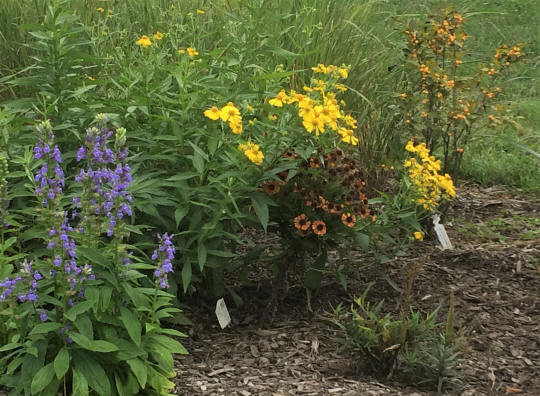(3/1) Nature has always been multitasking! As an open field reverts to a forest, it goes through a succession of stages, each featuring suitable plants with their associated insects, birds and other animals. It doesnít matter whether the land is dry or wet or even infertile, Nature has beautiful plants to fix that. And they usually carry on more than one important ecological task at once.

Most of Pennsylvania was covered in forest before European settlement. Areas of the forest were opened by human settlement, or random events such as fire, ice, and wind. Once the disturbance was past, Nature immediately began to fill in that open space. Succession happened.
Weíve removed a lot of forest in the last 340 years, leaving open spaces of lawn and many non-native species, and Nature is left struggling. Her native insects cannot find enough food, while hungry foreign insects are driving farmers and homeowners crazy. Nesting birds canít find enough native caterpillars to feed their chicks, and the butterfly bush featured in box stores attracts butterflies for nectar but it doesnít nurture caterpillars. Specialized insects arenít finding the specific host plants they need for food and reproduction.
We shouldnít despair. We can help Nature bring our landscape into balance again. She gives us infor-mation, and generations of ecologists have diligently taught her methods. They studied forest openings and abandoned fields, noticing which plants colonize these spaces. They observed the plants and de-termined many of their talents at soil building and nutrient accumulation. They watched and identified the insects, birds, and other animals that inhabit these areas to determine how sunlight energy moves from photosynthesis in plants to the animals that eat them.
Landscapers specializing in rebuilding natural systems are learning from the ecologists, and in turn, help-ing the rest of us build natural, insect friendly, and songbird friendly backyards. As homeowners we can educate ourselves, finding out what sort of plants might please us, as well as bees, butterflies and bene-ficial insects. Good places to start are the Penn State Extension websites featuring articles about polli-nator and wildlife friendly landscapes. (See two suggestions below.)
Native plants carry on several important ecological tasks while simultaneously pleasing our senses. We can feature native perennials, as well as native shrubs and trees in our landscaping. This strategy places a lawnís progression to forest at the stage which encourages the greatest diversity for insects and birds, too.
The most obvious task is providing pollen and nectar for bees, as well as foliage for animals. Letís look for varieties that are host plants for specific insect species, but not rabbits and deer. We know species of milkweed (Asclepias ssp.) are host plants for monarchs, but Golden Alexanders (Zizia Aurea) host Black Swallowtails and Pearly Everlasting (Anaphalis margaritacea) hosts American Painted Lady butter-flies, too.
When considering how best to provide pollen and nectar, remember that different species of bees are only active for a part of the growing season, but some, like bumble bees, are active all season. This means we should provide a progression of blooms through the entire growing season. Different species of bees have varying tongue lengths, leading to different abilities to drink nectar from flowers. Consider planting species with open blooms, especially members of the Aster and Dill families, as well as species with tubular blooms, such as species of the Mint family. And invite the other pollinators, too ó flies (syrphid flies and tachinid flies), beetles (ladybugs and fireflies), lacewings, wasps, ants and more. Many of the non-bee insect pollinators are also predators on insect pests we donít want in our gardens. Think how useful it is to have ladybugs managing aphid outbreaks for you.
Many of the native plants beloved by insect pollinators have deep roots allowing them access to deep soil water during droughts, and several of them donít mind soil that is occasionally soggy either. If you have a piece of lawn that collects water, consider a rain garden full of the native perennials to control your runoff and consume insect pests. It solves the problem and increases the natural capital provided by your property.
Many deep-rooted native plants grab soil nutrients before they leave your property in ground water. Nitrogen, phosphorous, and mineral nutrients easily dissolve in water, then move down through the soil to the water table. The water below that line moves downhill through the ground and away from your property. But if you have deep-rooted native plants, they act as nutrient accumulators, hanging on to nutrients, even bringing them up into their foliage. As foliage drops off in the fall, donít rake it away; leaving it through winter gives your insects a winter home. The following spring, you can rake the dead material, along with any leaves that have accumulated through the winter, run it through a chipper or compost it, and then put it back on the garden. You are recycling nutrients that would otherwise be lost.
As you add more native plants to your landscape, watch to see how nature is working to repopulate your yard. Before you know it, there will be an attractive natural system with expected and unexpected creatures to enjoy.
Articles featuring pollinators and pollinator habitat: https://extension.psu.edu/insects-pests-and-diseases/pollinators/habitat-and-landscape.
Articles featuring wildlife friendly landscaping: https://extension.psu.edu/landscaping-for-wildlife-trees-shrubs-and-vines.
Read other articles on garden and landscape design
Read other articles by Debby Luquette